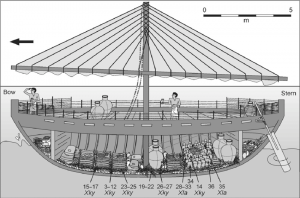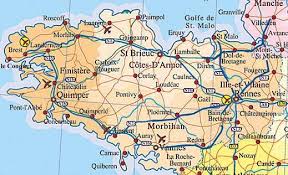Reinoud deJonge
Uluburun Shipwreck
The Uluburun Shipwreck is arguably one of the most important underwater discoveries of the 20th century. It was located in 1982 not very far from the town of Kas in southern Turkey. Eleven consecutive campaigns of three to four months duration took place from 1984 to 1994 totaling 22,413 dives, revealing one of the most spectacular Late Bronze Age assemblages to have emerged from the Mediterranean Sea(a). Because the wreck lay at a depth of 44-61 metres divers could only spend a very limited time  working on it, hence the large number of dives involved.
working on it, hence the large number of dives involved.
Radiocarbon dating techniques and the presence of identifiable pottery types place the date of the wreck as sometime in the late 14th century BCE, probably between 1330 and 1300 BCE.
>Peter James wrote a highly critical paper regarding the dendrochronological dating of the Uluburun shipwreck explaining “why the Uluburun date is dubious in the extreme and how its status as a ‘scientific’ date has gradually unravelled”(e).<
The main cargo of the ship was raw materials. The largest items were copper ingots, 348 of them, totalling 10 tons in weight. These took the form of ‘oxhide’ and circular buns, which refers to the shape they had, forms common in the Bronze Age Mediterranean(b). Isotope analysis revealed the ingots were pure copper and from Cyprus(c). Additionally, the cargo included a ton of tin ingots. These metals were estimated to be enough to make 5,000 bronze swords.
It did not take long before this discovery generated some wild speculation J.S. Wakefield & Reinoud DeJonge proposed that the Uluburun copper had come from the Michigan mines in their book Rocks & Rows, Sailing Routes across the Atlantic and the Copper Trade [760]. The late Gavin Menzies went further and proposed that not only was the Uluburun copper from Michigan but that it had been brought from America by the Minoans identified by him as Atlantean.
Now that exploration of the wreck has finished, scientists are engaged in a study of the amazing array of artefacts salvaged. Articles in 2022 and(d) 2023(f) revealed some of the unexpected discoveries made, including the source of the tin ingots.
(a) https://en.wikipedia.org/wiki/Uluburun_shipwreck
(b) https://www.worldhistory.org/Uluburun_Shipwreck/
(c) Isotope analysis reveals origins of Uluburun shipwreck cargo | The Past (the-past.com)
(e) https://www.centuries.co.uk/uluburun.pdf *
(f) https://www.re-thinkingthefuture.com/2023/02/18/a9360-lost-in-time-uluburun-shipwreck/ *
Brittany *
Brittany in northwestern France is sometimes referred to as Little or Lesser Britain. It is one of the most exciting regions of Megalithic Europe. The stone rows of Carnac are unequalled, Le Grand Menhir Brisé was once the largest standing stone in Europe, while  Morbihan contains a huge number of dolmens and standing stones.2019 saw a report that “Bettina Schulz Paulsson, an archaeologist at the University of Gothenburg, reexamined some 2,410 radiocarbon dating results that have been assigned to Europe’s megaliths and put them through a Bayesian statistical analysis. Based on the picture the data presents, Schulz Paulsson believes that the megaliths were first constructed by dwellers of northwest France during the second half of the fifth millennium BC.” (b) Both Robert Hensey, who has studied and written about Newgrange [1766.6] and Mike Parker Pearson, Stonehenge’s leading, authority, have endorsed this idea of a French origin for megalith building(c).
Morbihan contains a huge number of dolmens and standing stones.2019 saw a report that “Bettina Schulz Paulsson, an archaeologist at the University of Gothenburg, reexamined some 2,410 radiocarbon dating results that have been assigned to Europe’s megaliths and put them through a Bayesian statistical analysis. Based on the picture the data presents, Schulz Paulsson believes that the megaliths were first constructed by dwellers of northwest France during the second half of the fifth millennium BC.” (b) Both Robert Hensey, who has studied and written about Newgrange [1766.6] and Mike Parker Pearson, Stonehenge’s leading, authority, have endorsed this idea of a French origin for megalith building(c).
The earliest suggestion that Atlantis may have been connected with the Armorican peninsula came from François Gidon in the 1930s when he proposed that Atlantis had been situated on an exposed Celtic Shelf stretching from Brittany to Ireland. Unfortunately, he dates the submergence of this land to between 3000 and 1200 BC, which was millennia after that part of the Celtic Shelf had been inundated by the Flandrian Transgression.
Jean Markle was convinced that the Carnac stones were connected with Atlantis. Recently, Sylvain Tristan followed the work of Jean Deruelle in supporting a megalithic Atlantis. Further support has come from Alfred deGrazia and Helmut Tributsch who saw Megalithic Europe as Atlantis with the island of Gavrinis in Brittany as its capital.
The American researcher, Hank Harrison, considers the Morbihan départment as a significant Atlantean location if not the home of its capital.
Reinoud deJonge proposes even greater significance for the Brittany megaliths with his claim that they record the Flood of Noah in 2344 BC(a).
A fairly lengthy illustrated paper regarding ancient catastrophes in Brittany is available online(d).
(a) See: Archive 2501
Dodwell, George F.
 George F. Dodwell (1879-1963) was a leading Australian astronomer, who made an extensive study of ancient gnomons and discovered that they deviated from what had been anticipated. A gnomon is the part of a sundial that casts the shadow. He concluded that there was consistent evidence that the tilt of the earth’s rotational axis was altered around 2345 BC. This view supported those that have claimed that the poles shifted within the memory of man, possibly as a result of a close encounter or impact with an extraterrestrial body such as a comet. Some have gone further and attribute the destruction of Atlantis to this clash. Dodwell’s complete work on the subject can now be read on Barry Setterfield’s website(a).
George F. Dodwell (1879-1963) was a leading Australian astronomer, who made an extensive study of ancient gnomons and discovered that they deviated from what had been anticipated. A gnomon is the part of a sundial that casts the shadow. He concluded that there was consistent evidence that the tilt of the earth’s rotational axis was altered around 2345 BC. This view supported those that have claimed that the poles shifted within the memory of man, possibly as a result of a close encounter or impact with an extraterrestrial body such as a comet. Some have gone further and attribute the destruction of Atlantis to this clash. Dodwell’s complete work on the subject can now be read on Barry Setterfield’s website(a).
Dodwell, a devout Christian, concluded that it was this sudden shift of the earth’s axis that led to the Flood of Noah. Reinaud de Jonge proposed a similar linkage between the 2345 BC cosmic encounter and the biblical Deluge. He also claimed that a large collection of petroglyphs at Mougau-Bihan in Brittany were inspired by this event.
Rene Noorbergen (1928-1995) mentions in his Secrets of the Lost Races [612.20] that Dodwell wrote to Professor Arthur J. Brandenberger of Ohio State University, outlining his theory in the following manner; “I have been making during the last 26 years an extensive investigation of what we know in astronomy as the secular variation of the obliquity of the ecliptic. From a study of the available ancient observations of the position of the sun at the solstices during the last three thousand years, I find a curve which, after allowing for all known changes, shows a typical exponential curve of recovery of the Earth’s axis after a sudden change from a former nearly vertical position to an inclination of 26½ degrees, from which it was returned to an equilibrium at the present inclination of 23½ degrees during the interval of the succeeding 3,194 years to A.D. 1850. The date of the change in the Earth’s axis, 2345 B.C., is none other than that of the flood recorded in the Bible, and the resulting conclusion is that the Biblical account of the flood as a universal one, together with its story of Noah’s Ark, is historically true.”
Dodwell was also impressed by the work of the creationist, George McCready Price (1870-1963), who had also concluded[1616] that the Earth’s axial tilt had been altered as a result of an impact with a celestial body. Price also linked the event with the biblical Deluge.
Dodwell referred to a paper of F.S.Richards on the orientation of the Temple of Ammon at Karnak(b), which indicated an anomalous obliquity of the ecliptic of 25°9’55”. This led to considerable debate regarding the age of the temple. William Fix drew attention[871.264] to the widespread reuse of very ancient sacred sites by successive cultures, which might explain the incompatibility between the apparent age of the most recent temple and the greater antiquity suggested by the obliquity of the ecliptic. Alternatively, it might also indicate an encounter with an extraterrestrial body that affected the Earth’s axis and caused widespread destruction, including, according to some theories, the destruction of Atlantis!
S.F. Wells published a paper(h) on Graham Hancock’s website in which he investigated the Avebury stone circle and its associated monuments and found evidence that they “show knowledge of past Polar positions”.
In the interests of balance, I must refer readers to an extensive 2013 paper(f) by a creationist, Dr Danny Faulkner, who has cast doubts on Dodwell’s conclusions. More recently Paul Dunbavin also published a positive critique of Dodwell’s work in Prehistory Papers [1758.71]. This essay was written a few years ago and is now available on his website(k)>>as well as the academia.edu website(l).<<
Another interesting comment is offered by Barry Setterfield, who wrote(a) that “ Dodwell has assumed here that the original axis tilt of the earth, before 2345 B.C., was nearly upright. For that reason, he supposed a very strong impact was necessary to jolt the earth from that position to its current 23.5-degree tilt. This is why a number of astronomers have rejected Dodwell’s work in this area. However, if the axis tilt was greater than its current axis tilt before 2345 B.C., then an impact of much less force would have been required to restore the earth to a slightly more upright position. The evidence for this greater axis tilt may be seen in the evidence of the ice age which covered most of Europe prior to 2345 B.C.”
Malcolm Bowden, the author of True Science Agrees with the Bible[1612], also wrote a pamphlet[590] supporting Dodwell’s findings and later produced a YouTube video explaining in detail Dodwell’s axial tilt theory(g). Paul D. Ackerman offers another review of Dodwell’s work from a creationist viewpoint(j). Ackerman is an ardent supporter of the concept of a young Earth [1727].
In 2011, Mike Baillie, the renowned dendrochronologist, gave a PowerPoint presentation(d) at the Quantavolution Conference in Athens, which offered tree-ring evidence that clearly demonstrated an ‘event’ in 2345 BC, which has counterparts in early Chinese and Middle East records suggesting a cometary encounter/impact! Baillie also notes that Isaac Newton and Edmund Halley both thought that Archbishop Ussher’s Flood of 2349 BC was due to a comet.
As early as 1696, William Whiston claimed that the earth’s encounter with a comet led to the biblical Deluge.
More recently, Andrew Bourmistroff, a Russian researcher, has determined that the orientation of the Great Pyramid at Giza is off by 9.85 degrees west of true north(e). The full significance, if any, of all these details has yet to be fully determined.
(b) Wayback Machine (archive.org)
(d) https://www.qconference-athens-2011.grazian-archive.com/the2345topicmbai/index.html
(e) https://web.archive.org/web/20150909160031/https://www.world-mysteries.com/andb1.htm
(f) https://answersingenesis.org/astronomy/earth/an-analysis-of-the-dodwell-hypothesis/
(g) https://www.youtube.com/watch?v=21WvVH4CXR4
(h) https://grahamhancock.com/wellssf1/
(i) THE COMET CATASTROPHE OF c.2345 BC – 1 (archive.org)
(j) https://creationism.org/csshs/v07n4p02.htm
(k) Updating George F Dodwell | pauldunbavin (third-millennium.co.uk)
(l) (96) Updating George F. Dodwell | Paul Dunbavin – Academia.edu *
